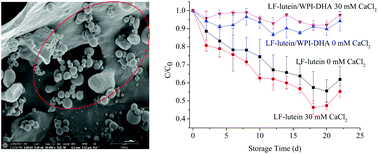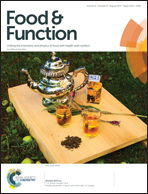Influence of calcium-induced droplet heteroaggregation on the physicochemical properties of oppositely charged lactoferrin coated lutein droplets and whey protein isolate-coated DHA droplets
Abstract
The influence of calcium-induced droplet heteroaggregation on the formation and physicochemical stability of mixed lutein and DHA emulsions was studied. Heteroaggregation was induced by mixing oppositely charged lactoferrin (LF)-coated lutein and whey protein isolate (WPI)-coated DHA emulsions with different CaCl2 concentrations at pH 6.0. The droplet size, zeta-potential, transmission-physical stability and microstructure behavior (CLSM and Cryo-SEM) of single-protein emulsions and mixed emulsions were measured as a function of different CaCl2 concentrations. Lutein degradation and DHA oxidation by measurement of lipid hydroperoxides and thiobarbituric acid reactive substances were determined during storage. The physical stability of the mixed emulsions could be modulated by controlling CaCl2 concentrations. Microstructure behavior indicated that a mixed emulsion with 30 mM CaCl2 promoted more droplets to form a special three-dimensional network and microcluster structures. The chemical stability of the mixed lutein and DHA emulsions was obviously enhanced by the addition of 30 mM CaCl2. The decreased surface areas of the DHA and lutein droplets and the physical barrier of the network of heteroaggregates against transition metals and free radicals could mainly explain the improvement in chemical stability. Calcium-induced droplet aggregation may be useful for creating specific food structures that lead to desirable physicochemical properties of multiple functional components.



 Please wait while we load your content...
Please wait while we load your content...